De Bellis Antiquitatis 3.0 (WRG Ltd, Cambridge, 2014), written by Phil Barker and his wife Sue Laflin is the 3rd major update of a ruleset first designed in 1988 as simple experimental fastplay game for a Society of Ancients convention. DBA was published in 1990 as a commercial ruleset.
In my quest to thoroughly review and compare 5 popular Ancients I tested DBA 3.0 three times with the Mons Graupius wargame scenario, as I did with LWTV Age of Hannibal, before. It’s a structured review with a topic list.
General characteristics
Fastplay as a new concept in 1990
Nobody who grew up in the 21st century seems to know DBA anymore. At my club, the 40K-generation stares at me. “What is it? A computer game?”
But back in the nineties, during the Madonna, Two Unlimited, Michael Jackson, George Michael and Nirvana years, everybody played DBA. Gamers, then and now, like competitions. DBA changed the wargaming scene and made fastplay possible. Slow gaming was getting out of fashion. Instead, Phil Barker cs presented rules with clear army lists and a system for battles with relatively few figures. American wargame veteran Bob Beattie remembers, about the early years:
“What followed in the next ten years in the hobby is nothing short of amazing. Not just for the ancients/medieval area, but for the hobby as a whole. Truly a paradigm shift if there ever was one. Would I be going to far to say it was like the impact of Rock and Roll on popular music in the 50’s!? (…) [Before DBA] I saw folks at conventions, bent over tables filled with beautiful figures and colorful terrain, seeming to have much fun “discussing” the rules. They did not play all that much, mostly lots of discussion. On the sidelines a few onlookers chided the gamers for the “unhistorical match-ups.” Those did seem strange, maybe bordering on fantasy. [After the introduction of DBA] We all went to Historicon the next year and played in a tournament, one of the group even had Phil [Barker] as an opponent. We were doing “unhistorical” match-ups but it did not seem that bad. We were not discussing the rules that much, we were actually playing games; 4 in an hour! I put on a big battle of Hydaspes that was not even in the program but which filled up as soon as I set it out.”
Mother of many other systems
DBA was/is, as stated in the book’s introduction, “one of the most influential wargames rule sets of recent times”. Wikipedia states anno 2022 that games like Art de la Guerre, (Basic) Impetus, Sword and Spear, To the Strongest! and Triumph! were influenced by or derived from the original DBA rules. “These systems tended to retain similar basing standards compared with DBA, but strived for an overall clearer presentation (…) while modifying existing units and/or introducing new ones (…) They also aimed to offer a more streamlined player support (…) Most systems abandoned the traditional 12-elements army model, and created a point-based system to allow more balanced confrontations between armies.
DBA, DBM, DBMM and now DBA 3.0
Barker developed DBA 1.1. into DBM and DBMM. TMP Forum member and DBx playtester Thomas wrote about these later DBx variants:
“DBM was at one point the dominate game for ancients and medievals. Up until version 3.0 it was both a great tournament game and a wonderful simulation. When version 3.0 appeared it became a tournament game and eventually faded to a niche of hard core players. DBMM was intended to replace aging DBM and attempt to restore simulation value of prior editions. Unfortunely the project got out of control and produced the almost unplayable DBMM 1.0 (…) after months/years of playtesting DBMM 2.0 appear – a far better version though still much too complex. My advice if starting is to get a copy of DBA3.0. (…) Most of the improved features of DBMM have been incorperted into DBA3.0 (and we also pruned many unnecessary parts).
Anno 2022, DBA 3.0 is available as LuLu print-on-demand book via Amazon ($18.42): 142 pages, 12 pages rules, 12 pages with diagrams/combat examples to clarify how the rules work, 102 pages with 313 army lists. They cover the period between 3000 BC to 1520 AD.
Scale, type of game, typical army size, game length
The standard game is commonly played with 15mm figures based on 40mm bases on a small, square 60/80cm by 60/80 cm-table (but it can be played with 28mm on a larger table, or with much larger armies). All armies, whatever their (relative) size, are represented als 12-element-armies: armies consist of different troop types (heavy cavalry, light horse, spears, pikes, skirmishers, bows etc) in different proportions, depending on their nationality. A basewidth is 80 ‘paces’ in real life.
Below a tailor made list to replay the famous Cannae-battle with just 12 bases:
- Romans — 2xCavalry, 10xBlades. This represents the fact that the triarii and velites didn’t seem to have a role in this battle.
- Carthage — 3xCavalry, 2xLight Horse, 5xAuxiliaries, 2xSpears, 1xPsiloi.
The army lists are divided in 4 periods: chariot pre-classical age, classical, early medieval and late medieval. The lists are as much as possible based on historical research with reference which an army’s historical enemies and allies were. A-historical match-ups are possible (Romans vs Samurai) if you want a change.
Generalship in this game is modeled as keeping good control over your troops, and a rock-paper-scissors approach that is more important than how many soldiers an army had. Morale, cohesion, and troop quality are absent as separate unit values or qualities, but considered as included in the specific combat results table and modifiers. The elite Macedonian Companions, for example, lead by Alexander himself, fought without stirrups. Nevertheless they’re rated as Knights, while the standard opposing Greek or Asiatic army has no Knight unit, only standard cavalry or light horse.
The bases represent large units. A base with 3-4 miniatures represents 500-1000 historical foot soldiers. About 50 miniatures is enough to represent a full historical army and fight a historical battle on a 60x60cm table. “A typical DBA game is usually completed in under an hour using a minimum number of model figures, making the rules equally suitable for home, club and competition play. Although designed for two players, the rules can also be used for larger games with multiple players and for refighting historical battles”, the DBA back cover text says.
Design Philosophy
The goal of the designer is/was to make a fastplay ancients set. The core general premises that underpinned the original DBA-rules can be summarized as:
- The broad tactical doctrine of troops was more important than distinctions of weapons.
- Simulation of historical battles can be done as well with simple rules as complex ones.
- It is better to model the effect of events (battles, command) than the detail.
To improve the game after decades of playing and prevent some cheesy, unhistorical tactics that some players frequently used (“Look! It’s in the rules!”), Barker and his wife and a large playtest-team updated and changed DBA 2.2. They also made the game more complex. A playtester nicknamed MedievalThomas wrote: “
As to DBMM and DBA 3.0, I did massive playtesting for DBMM 2.0, including having Phil come to the US to demo games with me. In the end I concluded that while DBMM tried to solve some of DBXs basic geometry problems – its massive complexity defeated the attempt. I then proposed the radical concept that we could get the DBMM solutions with much less complexity, if we set our minds to the task. (…) Phil sent me the first draft of DBA 3.0 and said OK lets give it a try.
So we have DBA 3.0 which is not a “reduced” version of DBMM but instead just a far more efficient version. We fix the same problems with maybe a third the rule overhead. Did we in the end need to explain things a bit better? Yes. Did we perhaps retain a few DBMM ideas we should have jettisoned (like the phantom overlap penalty)? Yes. But for bang for your buck there is nothing better in the (official) DBX world.”
The original 15 troop types became, Richard Bracey (BGG review) wrote, “nearly 40 based largely on details of equipment.” Historical refights are recommended to be played with 24 or 36 bases and extra rules. “In effect the designers have largely abandoned the first two of the principles outlined above and accepted that unit types have to model minor details of weaponry ancient commanders did not recognise and that more complexity is needed. Your mileage on this will vary with how much you agree with the designer’s decision”, Bracey writes. He concludes:
“If you think details of weapons are important and complex rules are needed you will probably still find DBA too simple. If you were convinced by the original design decisions these changes won’t sit well with you (the good news is several older versions are still played). On the other hand, if you care more about the game than the history this might be the version for you.”
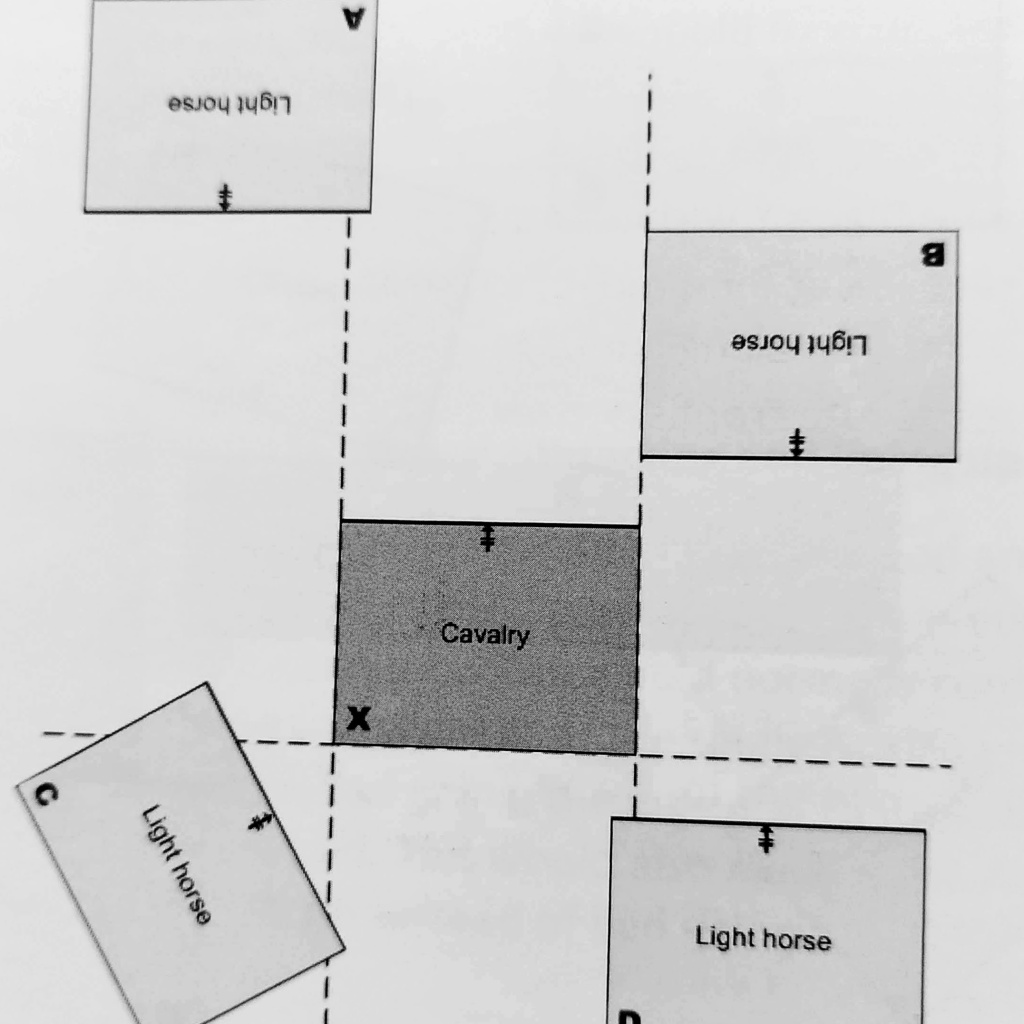
Wargame, chessboard style
The main idea of DBx is what I would call: “the virtual grid”. A geometrical, chessboard approach.
In front of a unit is a 40mmx40mm invisible ‘chess field’, called ‘threat zone’, and units must respect this zone, moving in or out this zone, or around it. Units are obliged to exactly conform to the front, flank or rear edge of the opposing unit base.
Overall book quality
Historical research: good. The army lists in the books are based on historical research, often Ian Heath books, and the comments “of many erudite contributors throughout the years”. However – does that make them correct? In fact we don’t know. How many elephants survived when Hannibal crossed the Alps? Only one? How (in)correct was Polybius, or Tacitus?
Professor Sabin, in Lost Battles, describes how hard it is to reconstruct battles and the composition of the armies. In other words, it’s a matter of personal judgment. More than that, Barker sometimes refers to historical novels that inspired DBA – yes, romantic fiction. So how ‘objective’ are the lists? The aforementioned Robert Bracey, IRL a curator at the British Museum, knows from his expertise that the DBA Arab-Indian list (III-38) is not evidence-based, “which means either Phil Barker made this list up or he copied it from some-one else who made it up. It is entirely a work of fiction.”
Similar: in my own game (below) I noticed that the Caledonians have no Light Horse. Phil Barker’s list is based on his own book Armies and Enemies of Imperial Rome and Agricola from Tacitus. Tacitus mentions (Caledonian) cavalry, that is absent in Barker’s list. Strangely, Light Horses are included in the Ancient British II/53 list.
Conclusion: Barker’s lists in the books, in use since decades, add flavour, are plausible and have proven their usability. Overall quality is good. Lists have probably inspired many other game designers. In the meantime gamers (and museum curators) should be aware that the well-researched lists are his personal interpretations. Game tools.
Clarity: below average. On the web people complain: “I’m being defeated by the dry, legalistic Barker-ese – by the time I work out what they’re saying, I’ve lost all interest in it!” WADBAG rewrote the rules, DBA was in their opinion “hampered by a cryptic writing style and its lack of clear diagrams and examples. In addition, the ambiguity of the language used has meant that a common understanding of what the rules really mean has been elusive.’ Complaining about Barker’s writing style has become a wargamer’s habit, a cliché.
As non-native speaker I noticed that DBA has a dry, functional writing style. It’s not as vivid or clear as a Sam Mustafa or Rick Priestley text. Barker uses jargon you have to get used to: Psiloi instead of skirmishers, bad going instead of difficult ground. And the layout doesn’t help. Small print, no fancy fonts, no text interspersed with diagrams, no pictures, no examples: very 1988, I had a typewriter and a Commodore 64 with a matrixprinter then. The main body of Barker-Laflin’s text is definitions and tables. That’s old school. Modern rulebooks describe a process: how-to. DBA describes a status: what is.
The 3.0 version is better than earlier versions, but still… suboptimal. The problem is IMHO more the interaction between text and diagrams than the writing style. In the main DBA-forum I found a discussion between Joe Collins, a DBA-playtester, and others, that says it all. Collins wrote about a certain paragraph:
“The second paragraph of “Moving into Contact with Enemy” lists the exceptions and the ramifications of those exceptions to the first paragraph. Yes,it is a bit muddy. I rewrote both these damnable paragraphs perhaps 20 times. They are better that when we started. Phil [Barker] did take some of my wording… but not all”. And about certain combat rules, Collins says: “this is inferred but not directly stated in the rules (though shown in the diagrams).”
DBA veteran ‘Stevie’ replied: “I used to think that the rules were the most important thing, and the diagrams and their dialogue were secondary. I have since changed my opinion…the diagrams and their accompanying dialogue are the rules. You see, the rules are somewhat generalised, and in some cases even vague.
The diagrams and their dialogue gives us what the rules don’t…practical examples of the rules in everyday use. Since I’ve started to treat the diagrams as actual rules, DBA 3.0 has become much clearer and easier to understand.
And playtester Medievalthomas added: “It would have been better to have integrated [the diagrams] into the text so you’d have both together but as we could barely get Phil to add them that was impossible.”
Visuals: below average. As said, the layout is totally unappealing and substandard compared to the average publication in this genre. The nineties-layout never changed.
Completeness: (very) good. DBA 3.0 is a complete set with terrain generation rules and army lists for the whole ancient and medieval period in the whole world. You can play a fast and simple pickup game, that’s the design goal, but the book includes variant rules for (very) big battles and historical refights. I can recommend the Great Battles of History supplement that can be downloaded for free. The older (simple) campaign rules have been deleted but can be retrieved online.
Online support: very good. This long-standing game has a large group of fans who publish blogs, free supplements, player aids, scenario’s and who maintain the Fanaticus forum. The game is also supported by the Society of Ancients. I downloaded a free 2-page quickref sheet from the SoA. This now more than 30 year old wargame is a classic.
The Game In Short
In DBA, players set up their armies for a pick-up game based on the army list, generate terrain and start an IGOUGO-game. A standard army has always 12 elements (bases) that can be grouped in 1 (all bases connected) to max 12 (all bases separate) groups. Per turn a player rolls a 6-sided dice (‘pips’), for the number of groups a player may move. During the game a player can freely split up groups or combine smaller groups into bigger groups as he likes, using the number of ‘pip’ (player initiative points) he has for that turn.
When in contact, units add modifiers and roll opposed dice to see who wins the combat. A large (modified) difference will destroy the losing unit, a small difference will result in a pushback, that breaks the line and involutarily split a group in two or three. Some units quick-kill other units, a small win is enough to destroy the base. For example: Psiloi (skirmishers) quick-kill elephants, elephants quick-kill knights, and knights quick-kill Psiloi.
The essence of DBA is, in other words, a tactical grid puzzle defined by limited movement, a combat results table and a rock-paper-scissors approach. The small board, small armies an 4-element-lost=defeat-rule make it a quick game.
(For 40K-players and others unfamiliar with the game: a more detailed description of the game mechanics can be found here.)
Random terrain generation gives some fog of war and the PIP-dice give friction. Experienced players know the strengths and weaknesses of every unit. A complaint from some wargamers is that the combat results table, combined with the strict movement rules, make the game too predictable, too generic. Dice chess! The lovers see that as a strength, the haters as a weakness.
- Caledonians-01: list II/60: General Calgalus on foot (3Wb): 2x Chariots (LCh), 8 x warriors (3Wb), 1x warriors (3Wb)
- Caledonians-02 list II/60: Subcommander Baccuppus on foot (1xWb): 2x Chariots (LCh), 8 x warriors (3Wb), 1x javelineers (Ps)
- Caledonians-03 list II/53 (Ancient British): Subcommander Bravoheartus in Chariot (LCh), 2x Lh, 3 x slingers (Ps), Druid Horde (7Hd)
- Romans, list II/56: Subcommander Frontalattacus on horseback (3Cav), 1x Equites (3Cav), 4x legionaries (4Bd), 3xAuxiliary pedites (4Ax), 1x Auxiliary pedites(4Ax), 1x Slingers (Ps), 1x Light Horse (Lh)
- Romans, list II/56: General Agricola on foot (4Bd), 1x Equites (3Cav), 4x legionaries (4Bd), 3xAuxiliary pedites (4Ax), 1x Equites (3Cav), 1x Slingers (Ps), 1x Lancers (3Kn)
Gameplay: Mons Graupius, the DBA-version

Three quick battles, standard format
I’m a seasoned wargamer who started years ago with DBA 2.2. but I’m not a regular player, so far, and I never played DBA 3.0. In DBA I’m an autodidact mostly.
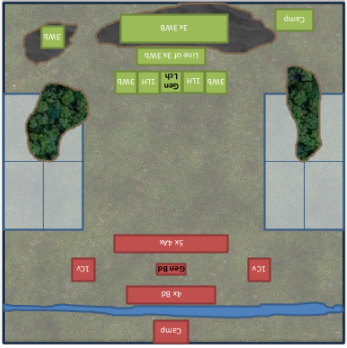
Me and my DBA opponent Henrique played this battle two times in the standard DBA version. Henrique played it first as solo game.
In Henrique’s interpretation, the Romans have a first line with 5 auxilia units (5x4Ax). The second line consists of 5 legionary units (5xBd, one unit a General), On the flanks and 2 Cavalry.
His Caledonians have a first line with two Warbands (3Wb, fast moving) on the flanks and light horse and chariot (General) in the center. Second line is three (3Wb) warbands (not giving rear support to the first line) and the third line consists of 4 (3Wb) warbands in the hills. The Roman legions and the Caledonian warbands in the hillls are not allowed to move until the first round of combat, so they both come too late.
He reported that the auxilia clashed with the Caledonian first line, and brought the Caledonians in disorder. That resulted in local Roman advantage (attackes with side support, ‘overlap’ in DBx-terms, higher dice bonus) so the Romans could destroy the general and 3 other Caledonian units quickly and decisively.
In retrospect, I think this was the logical effect of his setup: light horse is ineffective against auxilia, so statistically will often be destroyed or chased away, so the general’s chariot will lose his flank protection and, in the subsequent combat round, will be at disadvantage against auxilia who overlap him now.
I had my own interpretation that I tested in two games against him, as small 12-element vs 12-element battle. My list:
- Caledonians, list II/60: General Calgalus on foot (3Wb): 2x Chariots (LCh), 8 x warriors (3Wb), 1x javelineers (Ps)
- Romans, list II/56: General Agricola on foot (4Bd), 1x Equites (3Cav), 4x legionaries (4Bd), 3xAuxiliary pedites (4Ax), 1x Equites (3Cav), 1x Slingers (Ps), 1x Lancers (3Kn)

In this setup, the inclusion of Roman Psiloi make the Romans more vulnerable (you can quickly lose the Psiloi unit). Starting positions below.
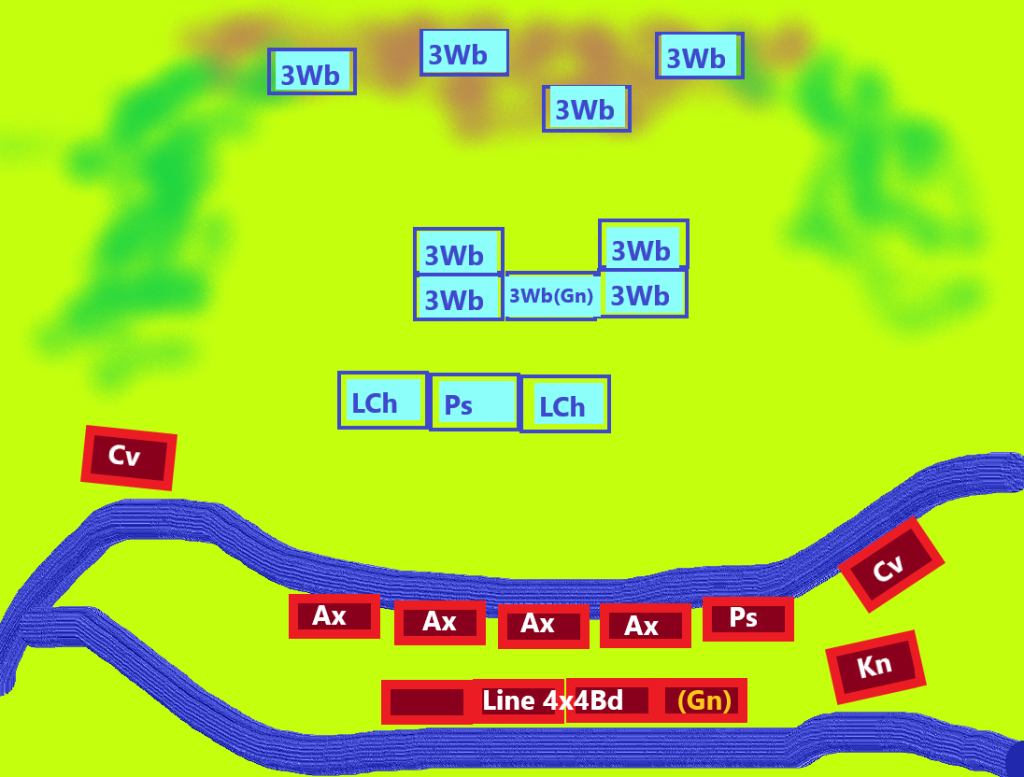
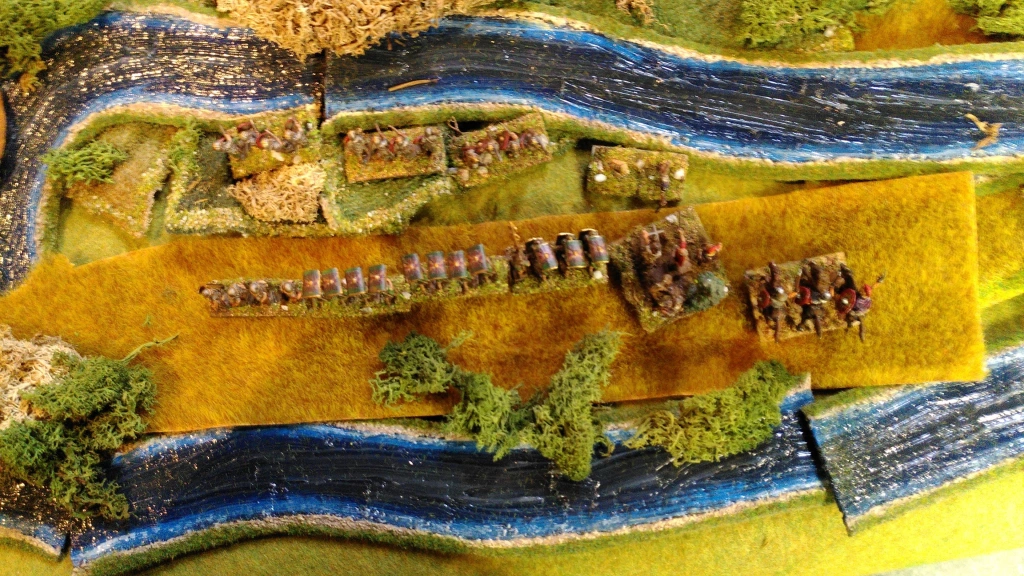
The Romans can threaten the Caledonian flanks with psiloi and cavalry if they cross the river (bad going) and regain order. The Caledonians are cornered and outflanked and have trouble with their disordered third line, but might be able to kill the Roman advance guard and storm the legions.
In our first game Henrique’s Caledonians won. He quickly destroyed the Roman cavalry and Roman psiloi with some luck, and by using the Caledonian psiloi for flank support (the Roman cavalry had drifted too far away, from the main force, and my Roman auxilia were too slow). The Romans struck back but when they lost their fourth unit the game was done.
We changed sides. This time Henrique won again, now with the Romans. The Caledonians moved forward and gave the auxilia a hard time, but a Roman Legion (Blades) and a Knight unit were just in time to save the day. Close battle.
A few observations after these first few games.
- The chosen list, setup and terrain matters
- the Roman/Caledonian lists are fair, balanced.
- we played two games in three hours, including beer & chat.
- the battles were decided in/after a few clashes. Tactical placement of units against each other, relative speed and moving around a flank and around an threat zone proved to be decisive.
- to play the game in the right way, you need to have a good understanding how you move in, out and around an threat zone and how you conform, and measure the movement, Henrique pointed me at a rule that he found in a diagram but not in the rules.
- I rolled badly all the time but ‘positioning’ was the core part of the game.
- It’s hard to maneuver Psiloi. A Roman army with Bows or an extra Auxilia unit instead of Psiloi might have been stronger.
An unequal medium battle
In a bigger battle 3 Caledonian armies battled 2 Roman armies
In this bigger battle Calgalus had 2D6 pip dice, and command range was measured from him only, to reflect the bettter Roman drill and the Caledonian command & control problems. We replayed it with veteran player Paul Hodgson (as Roman), a great afternoon in my backyard. Paul won, and I felt his skill and experience in how to handle the units and defend (possible) gaps was crucial in his victory.
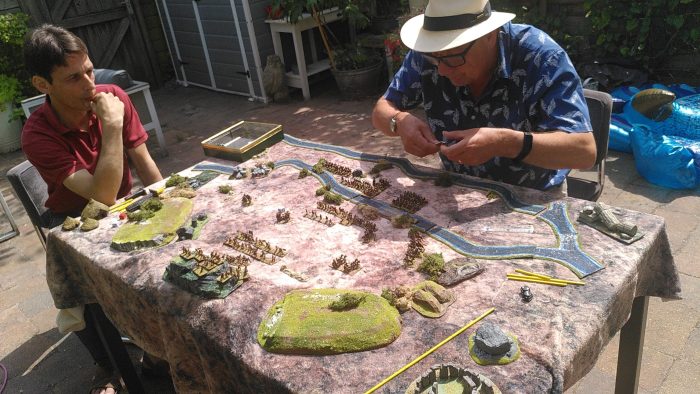
Dice mechanics and luck in v.2.2 an 3.0
The game is very logical, we continuously had to make choices how we spread and moved our units, constrained by the pip-dice, When in close combat the system was clear. Gameplay is consistent: shooting is not different from combat.
In earlier versions of DBA Roman blades were invulnerable according to some players, but in 3.0 this problem is solved. Blogger mrWritenow warned, about Warbands vs Roman blades:
“Warband’s claim to fame is that it can quick-kill heavy foot (such as spear, blade, and pike), but fights at just a +3. However, to mitigate this, warband receives rear support from warband, making it a +4 against those types. Now, warband is still fairly brittle against a blade line, which fights at a +5. One recoil is all it takes to make the fight a relatively easy +5/+3 for the blade. Warband is either going to win big or lose big against a blade line, and it really seems to be almost a toss-up.
Anyway, say that the blade line kills an element in the middle, leaving a nice big gap. In 2.2, the warband player could decide to swing a rear-supporting warband into that hole, sacrificing the support, but preventing a flank attack. In 3.0, that is no longer an option.
What I like
- It’s a simple, well designed game.
- It’s easily adaptable. Small, medium, large, simple rule changes possible… very flexible.
- Support is great. Large community.
- It’s a complete game. Rules and army lists in one book. Campaigns possible. Good tournament game.
- Thoroughly playtested. Robust rules. Cheap.
What I don’t like
- The layout and rule writing. These revised rules with revised layout are better than earlier versions, but still not clear. DBA would benefit if a modern editor would polish the rules or if fans make an unofficial rewrite – like the WADBAG version.
- PIP’s can dominate the game. The good side is also the bad side. DBA is a small game with few units that quickly get in close combat. It can be crucial if you can move that flank or not. The lower your PIP rolls, the more static your army is and that was sometimes frustrating, that a few random PIP scores can ruin every plan.
Final Verdict
Three stars. Good, maybe even ‘excellent’. I wouldn’t call it a beginner’s game, though. The system is simple when you understand it, but it takes a few games before you feel comfortable with the rules, the sequence of play and subrules explained in the diagrams. The v.3.0 variation in rules made it more ‘historical’ for some players, but also more complex. It’s the wargamer’s version of speed chess, and as such a great game if you play it against others who like fast wargames.
What Others Think
Heretical Gaming, like me, replayed Mons Graupius. From the 3 systems he tried (Polemos, Neil Thomas rules and DBA) DBA was
“the quickest game and the tightest written. It is the hardest to read initially because the information is given precisely and in the tersest way possible. It gives a brief but intense gaming experience. It can feel a bit blander historically than the other two.”
But:
“rules are pretty easy to understand once you get the hang of them, lot of subtlety in the rules created by the interplay of troop combat ratings and characteristics, comprehensive army lists, the D6 PIP roll does create simple but effective command dilemmas, although it lacks subtlety”.
He said that commanding Imperial Romans felt the same as commanding Caledonian tribal warriors. “The combat system is more variable than in the other two games: it is much easier to create almost certain wins in SPQR and A&MW than in DBA (I leave this to taste as to whether this is a virtue or a vice!)”
Balagan says it DBA is “light on simulation but quick and fun. The one day campaigns included in the book are brilliant”. He is critical about some of the choices made by Barker and his playtest team: Auxilia (important in Cannae) are too weak, pikes are a-historical weak, and the historical tactical interaction between bows, blades and mounted knights is wrong, in game terms.
Vincent Tsao also wrote a structured review of DBA 3.0. “The essence of the game is getting favorable match-ups vs. your opponent. Just as important is managing your pips. A plan that requires few pips is a good one (…) While [Barker’s] writing is sometimes difficult to follow, the rules system is ingenious. It’s worth the initial fuss. DBA set the bar for fast play rules (…) The game plays quickly. This is indeed the whole point of the game. Consider it the fast food of wargames (…) I won’t make the argument that the game is very historical. It is a game, not a simulation. It varies wildly by period and match-up of enemies. Sometimes it gives a pretty close simulation of the actual armies and other times can be pretty much a fantasy game. Rome vs. Celts works fairly well, as it should. These rules started as extremely fast-play game of Rome vs. Celts.”
Mr Writenow analyzed DBA 3.0 thoroughly. He concludes, after comparison with 2.2: “3.0 seems intent on solving problems that I didn’t think existed; issues like unfinished games (…) overuse of shifting lines (which was part of the fun) (…) corner-sitting, which involved deploying all the way in the corner of the board, and not moving the entire battle (…) Despite some of the negatives of 3.0– and they are significant– the game is still fun. I think that a few tweaks can really make it an excellent game again, one that feels more like 2.2 and not something else altogether. I think that some of these tweaks should be adjusting the movement distances of the elements to slow them the heck down, adjusting the deployment zone slightly so that you can’t start practically in contact with your enemy’s camp, and implementing something to mitigate the zone of control. If those changes are made– and believe me, those are significant, but not massive changes– I think that this could become a brilliant game once more. (…) The truth of the matter is that DBA 3.0 is a game that is, you know, fine. If I had never played DBA 2.2, I might even fall in love with it.“
Spear to the Strife-blogger reviewed DBA 3.0: “In short, I believe it is worth the added expense, and will provide a challenging and interesting battle at the medium complexity level quite well. Unfortunately, the original intent of a fast-play set of rules to teach newbies yet still challenge experienced gamers is gone. You would need help from a friendly guide or an experienced friend or the Fanaticus Forum. The only way I could see this playing quickly is if you used the same armies over and over again and became very familiar with the troop types, terrain, camp and BUA rules.”
Shaun Travers replayed Callinicum with DBA 2.2 and wrote: “DBA is the primary and worldwide leader in fast play ancient rules that plays on a 2’x2′ board in under an hour. I have played about 8 games over the last 15 years and it doesn’t move me. I don’t hate it, don’t love it, would just prefer to play something else. One of the things I don’t like is the lack of difference between good and poor troops (unlike its big brother DBM). I am also not fond of the PIP system – a range of 1 to 6 per turn for unit/group activation is just too much for me to rationalise.”
Deltavector, notorious game design writer, calls DBA one of his favorites, “a triumph of simplicity and elegance. The only mass battle ruleset I have minis based for”. And in a second blog: “It became a little stale and chess-like after a while; but was fun to play with others and its simple campaign system showed me that campaigns do not need to be complex to be fun – it can just be a way to logically link battles and enforce sensible concepts of when to withdraw.”
Ancient and Medieval Wargamings writes about DBA: “In my view DBA 3.0 is, without doubt, an outstanding package with a significant increase in presentation and clarity. While the rules are still simple the package, especially with the diagrams and army lists, will assist existing and future gamers considerably.”
DBA Links
outdated, but clearly written: the Unofficial Guide to DBA 2.2.+ by the Washington Area DBA Gamers. Still a pleasure to read.
More rule guidance, by seasoned DBA gamer Stevie:
static.wikia.nocookie.net/fanaticus-dba/images/c/cf/DETAILED_CRIB_SHEETS_for_DBA_3.0.pdf/revision/latest?cb=20170104004718
static.wikia.nocookie.net/fanaticus-dba/images/c/c8/DETAILED_RULES_INDEX_FOR_DBA_3.0.pdf/revision/latest?cb=20190304111629

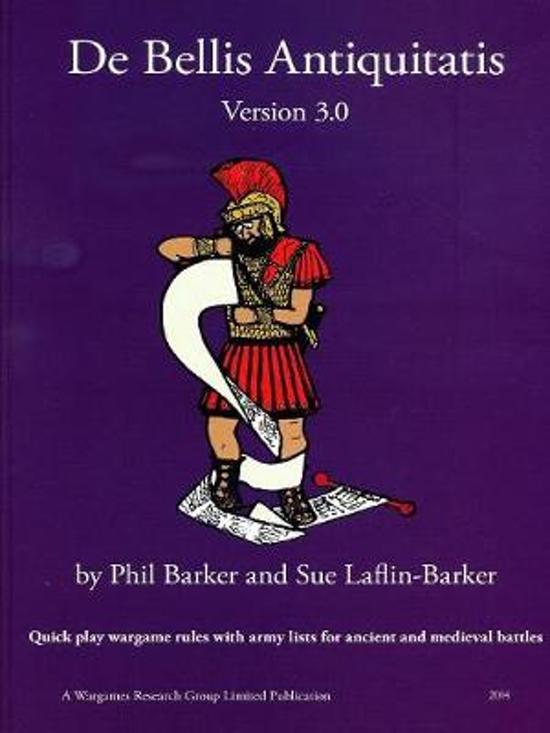
Although a devoted DBA 3.0 player, I broadly agree with your review.
In order to make DBA 3.0 more understandable and clearer to both
myself and when teaching my friends how to play, I made the following:-
https://static.wikia.nocookie.net/fanaticus-dba/images/c/cf/DETAILED_CRIB_SHEETS_for_DBA_3.0.pdf/revision/latest?cb=20170104004718
https://static.wikia.nocookie.net/fanaticus-dba/images/c/c8/DETAILED_RULES_INDEX_FOR_DBA_3.0.pdf/revision/latest?cb=20190304111629
See if these help you as much as they have helped us.
LikeLiked by 1 person
The actual historical basis for the lists is very good for the most part, with substantial contributions from people like Nigel Tallis, Duncan Head and Karl-Heinz Ranitsch among many others. Phil however, has arrived at his own conclusions in respect of some lists in which he takes a keen interest. I don’t agree with some of those, and I argued long and hard about one list in particular.
The language might be best described as very dry and precise, with some sentences being tricky to parse, especially as Phil’s English is in some respects quite dated.
But on the whole, DBA, (and DBM and DBMM) have provided me more gaming enjoyment than any other single set of rules. The real beauty of DBA particularly, is how low the barrier to play is. You are no longer paying for or painting hundreds of figures, and so players tend to amass collections of dozens of armies. Which is great, as you are then much more likely to be playing a historical matchup. To the criticism that a medieval foot Knight has the same effect on table as a Roman legionary, it matters only that the effect is correct against historical opposition. That medieval knight will slaughter Ribauds as effectively as Legionaries slaughtered unarmoured Celts, and struggle with the same tactical dilemma versus Pikemen as did the Romans facing Phalangites.
Are they perfect? No. I would change several things – the language, the effectiveness of pikemen. But on the whole, they will still give you an excellent and enjoyable game, and the opposed dice rolls for combat are still the most intense mechanism I have ever used to resolve combat.
LikeLiked by 1 person
A really good detailed review and replays. Even if I am only lukewarm to them (for me), I still think DBA is a great fast play 2’x2′ ruleset and everyone should try them if looking for such as set.
LikeLike
Excellent review. I play a lot of DBA, for all its weaknesses and strengths, and think your review was very fair comment. 👍🏼👍🏼
LikeLike
As a developer of DBA 3.0 and quoted several times in the article I thought I would add a comment or two. First why did we do 3.0? It had become clear that 2.2 was too static and predictable so we added more maneuver and greatly reduced geometric tricks one of you commentators lamented this added dash and loss of trickery in line flipping but this was the intent to make more of a generals game and less for rule lawyers. Added features were Overlap shooting and Fast troops both of which solved some issues with a minimum of fuss. No we have not abandoned the concept of depicting troops by function but simply brought the rules more in line with actual abilities. The system is not UgIg. Your movement is limited by opponents reaction simulated by PIPs you only get so many limiting what you can do both a simultaneous shooting and then combat phase followed by you opponent moving. This is highly interactive sequences of play. PIP efficiency depends on a grasp of period command control and player skill you can move the entire army for one PIP if well deployed. Of course your opponent will attempt to disrupt you deploy generally through Recoils which is a far superior combat result mechanism than ADLG book keeping mechanism (which otherwise is a good addition to the DBX family). DBX is work of genius but with flaws. Foremost is presentation something we are working on fixing as I type. The second though are the restrictive troop types which I am finding harder to get rationalization accepted for. Here ADLG does a better job. Still DBA 3.0 represents a high point in DBX development; I especially recommend Big Battle. The system still provides the best simulation for the fewest possible rule junk on the market.
LikeLiked by 1 person
I was also a ‘developer’ of DBA3. I think it’s fair to say that the final product satisfied neither of us. I wanted a full re-write for accessibility if nothing else. Phil said no.
LikeLike
Another really good and fulfilling post. Played the original DBA a few times. But never learned it enough. Have the 3.0 rulebook and I know a few locals have their armies left. Getting a few games in in a evening is a good thing now when I have 2 small children. I can get a few hours free at home. But not enough for a full dzc game. And Grimdark future (the absolute best and most easily 40k-copy out there) has some logistical issues as it still use a full sized 4’x6′ table.
So I might take a look at the game again soon. Thanks.
LikeLike